NB: There are photos in this post of animals that did not survive the drought. I’ve included these not to be distasteful but to show just how desperate the outback can be when water is sparse and the competition to survive dominates the animal kingdom in severe conditions. It’s difficult to describe the scenes when a picture can paint a thousand words.
We arrived in Marla and before we knew it we were off the Greyhound bus, we had met Gill our new host, put our large backpacks up on the back of the truck and were homebound. We were put straight to work along the way helping to dish out the ‘lick’ – 25kg bags of cattle food poured out into old tyres that are positioned all over the station near water sources as a back up for when there is very little grass. The cows end up eating tree leaves and bush leaves that are not too good for their stomach and the lick helps them to digest these. Dishing out the bags of lick, we are learning, provides a key role in the daily jobs at the station and are positioned so widely spread out that it can take a few hours each day and quite a few kilometres to get around and fill each one. Each tyre needs to be topped up every 2-3 days and with the many hands helping with all sorts of jobs it can be challenging to keep track of what area received food and when.
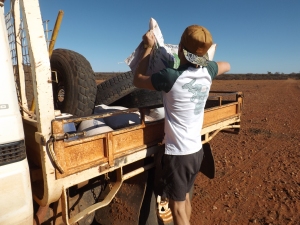 There are many jobs to do here, it’s difficult to know where to start. After a quick tour of the main roads, tanks and banks we got to the home station in time for dinner. We met all the family on our first evening – 2 boys, Alan age 9 and Stephen age 4, Mark (Gill’s husband), Mark’s parents, and his Grandparents. Turns out Australian’s in the outback are very family orientated! The cattle station keeps ticking over because everyone chips in, even Stephen. Planning is important. Mark and his father take charge and decide who’s doing what, Adam and I follow suit and work wherever we are told and when! Our day starts at the crack of dawn and changes depending on the sunrise. Usually the time of the alarm clock varies accordingly and we’ve timed our visit perfectly for the winter hours – so a 6:30am wake up is acceptable most days (otherwise we’d be on for around 5am)! This means we’re usually tucked up in bed by 9:30pm and are struggling to keep our eyes open! Though, as always, no matter what time you go to bed in the evening, you still can’t open your eyes the next morning! We are getting used to getting ready quickly. Worryingly there’s been an increasing number of times that I’ve thrown an outfit on in the dark and only later noticed that not only is my top on backwards but it’s also inside out. Good thing there’s no-one around to keep tabs on my appearance! Finding straw in my underwear and half the sand supply in my boot by lunch time is now normal.
There are many jobs to do here, it’s difficult to know where to start. After a quick tour of the main roads, tanks and banks we got to the home station in time for dinner. We met all the family on our first evening – 2 boys, Alan age 9 and Stephen age 4, Mark (Gill’s husband), Mark’s parents, and his Grandparents. Turns out Australian’s in the outback are very family orientated! The cattle station keeps ticking over because everyone chips in, even Stephen. Planning is important. Mark and his father take charge and decide who’s doing what, Adam and I follow suit and work wherever we are told and when! Our day starts at the crack of dawn and changes depending on the sunrise. Usually the time of the alarm clock varies accordingly and we’ve timed our visit perfectly for the winter hours – so a 6:30am wake up is acceptable most days (otherwise we’d be on for around 5am)! This means we’re usually tucked up in bed by 9:30pm and are struggling to keep our eyes open! Though, as always, no matter what time you go to bed in the evening, you still can’t open your eyes the next morning! We are getting used to getting ready quickly. Worryingly there’s been an increasing number of times that I’ve thrown an outfit on in the dark and only later noticed that not only is my top on backwards but it’s also inside out. Good thing there’s no-one around to keep tabs on my appearance! Finding straw in my underwear and half the sand supply in my boot by lunch time is now normal.
You know that whatever your chosen outfit is, by 9am it will have a new patterned combination of saliva, red earth and fur from numerous animals – but for some strange reason it doesn’t matter. It feels like you’ve earned it during feeding time and its the animals way of saying thanks I guess! You then spend the rest of the day not caring that you look like you’ve been dragged through a bush backwards and we’ve started to enjoy looking like we’ve worked hard! Adam seems to particularly enjoy wearing white t-shirts….which will now never be white again. His black tops seem to have no purpose. Anyway, life here is different. There are other things to shovel your energy into. By 8am the animals close to the house are ready to be fed and they’ll let you know it too. Momma Cat will be waiting outside the cabin door ready to capture our attention the second we are awake and Snowy the calf will be mooing whilst I’m on my way over to the house at 6:30am. 8am is their feeding time and it’s difficult to stick to when they’re begging – you’d think they haven’t been fed for days! When we’re up so early it’s easy to get lots of things done. As soon as the sun rises at 7am there’s no time to waste, most days the first sign of winding down for the day is at sunset. Once the ‘local’ animals have been fed it’s time to feed the thousands that are further afield. The station is home to around 4000 cattle, grouped into paddocks around the land. They usually stay within a 10km walk of the water supply nearest to them – quite often much closer in the hot weather, so it can be fairly easy to keep tabs on what they are up to. Though the roads to get there are something we’ve never experienced before.
You can only drive a 4×4 here on the station – if you want the suspension and 4 wheels to remain intact. This is not a reflection of the quality of roads, there’s a main road leading directly from the house straight out to Marla town (you could probably get away with a normal car on this road). The other roads lead off into the outback over terrain that wasn’t designed for vehicles. The family here have had a very difficult job of clearing the rocks and sand to make a clear space suitable for the road. Without the road it would be near impossible to get over the land to feed and check water supplies for the cows. Thinking about it though, despite only being here for just over four weeks, I don’t remember what it feels like to be on a smooth tarmac road. We’ve become well accustomed to the rocky road, it does require speaking very loudly in order to hear each other over the sound of rocks and revs. Balance is also key as the rocks really try their best to throw you out of your seat. Life can be made difficult with nearly every road looking identical to the next. We do have a map, but to start with (as I’m sure you’ll agree) navigating 1 million acres was tricky. You start to look out for signs and signals that may indicate that you’re moving in the right direction – a rock, a tree or a dead animal – anything to give you a hint. The tanks or banks are located all over the station, with purpose and precision. We still need practice with learning their exact location, but we are gaining confidence on lick runs and have quickly learnt routes and techniques to remember which one’s are where. Cows are a good sign, even seeing their tracks, they don’t go too far from water so you know you’re on the right track. Kangaroo’s are also a hint that there’s a water source nearby – however this can be misleading due to the thousands that live on the land. They pop up and jump out in front of the vehicle before you’ve got time to blink. On one lick run we had been driving for a good 30 minutes and hadn’t seen an ounce of wildlife, as I said ‘We haven’t seen any kangaroos today’ 6 came bounding out of the hedges and began gunning down the road in front of us! It’s like they heard me.
There is a lot of wildlife to see at Lambina (pronounced Lammina) Station. Cows (obviously), cats, dogs, chickens, ducks, geese, kangaroos, goannas, emu’s, camels, wild dogs, dingos, wild horses, pet horses, eagles, geckos, rose-breasted cockatoos (or Eolophus roseicapilla for all the bird nerds), topknot pigeons, willie wagtails and so many more. We have seen most of these animals on a daily basis, it’s definitely a perk of the job to see species that are native to Australia so regularly.
There are pro’s and con’s of having such a large range and abundance of wildlife on the land. You spend everyday ensuring that there’s enough food and water and provisions for the cows so that they can survive the daily struggle out in the sun and heat. But by default, having readily available water and food means that the wild animals can easily source this too. Camels, Horses and especially Kangaroos survive here solely because of the resources that the family provide for their cattle. This does mean that the cows miss out sometimes and that by the time they come back to the trough for a drink and snack, someone’s beaten them to it! In the middle of a drought there is no abundance of water, there is no grass and little shade, so provisions are thin. Without such supplies the majority of the animals on the station would not be alive – that goes for anything owned or wild. This is important to remember when you see the number of dead animals scattered across the land. It is at first difficult to adjust to. On our first run from Marla to the station we saw 3 dead cows. Most would be dead from botulism, spread through kangaroos that have died in the water source which the cows have then drank from. Usually the kangaroo would have been chased by wild dogs or wedge-tail eagles and in a state of panic it has jumped into the water as a reprieve but quickly it runs out of the energy and can’t get back out. It dies, starts to decompose and leaves a toxic that contaminates the water. The clue that the cow has died of botulism is that its tongue will be hanging out of its mouth. The added toxins, to a cow that can already be quite dehydrated and thin, is a recipe for disaster. There is then the temptation by the other cows to eat this ‘fresh meat’; and so, the dead cow gets nibbled and other cows are subsequently affected. It’s a job in itself to try and stop this from happening. You must wait for the cow to dry out, then return and burn the carcass.
We had been warned about the dead kangaroos in the water but hadn’t seen any until week 2 where we found 3. Adam showed his true chivalry skills and did the honours of pulling the dead beasts out. This is up there with the most gruesome of all jobs on the station, not knowing how long the kangaroo has been sitting in the water only adds to the mystique of the situation. The first clue you get is whether or not their insides are now comfortably on the outside – we did get the delight of observing this (well I did, whilst Adam nearly broke his back pulling it out of the water). Sometimes Rigor Mortis has set in and the kangaroo is frozen in a stiff position, this is both strange and creepy as it looks like it’s posing. With Kangaroos in abundance and often playing chicken with the cars, they do tend to find themselves as dog meat. We see chefs on TV using ‘tender kangaroo meat’ for their next fine cuisine meal – this surely means that the dogs here are well fed (though the family don’t eat it, so maybe not)!
Our very first full day of work saw us digging trenches with shovels and getting amongst the sand and dust to create a bed for a new pipe to lay in; linking a new tank and trough being installed in one of the paddocks. It was hot and sandy with plenty of flies. You’ve got to be strategic with breathing to avoid a) dust and b) bugs. It’s no concern for a conversation to be interrupted by random blows of air as you breathe upwards and curl your bottom lip around your top lip to disrupt the obnoxious flies that have set up camp in your left nostril. The flies chase moisture and your eyes, ears and nose seem to be their chosen destination. The advice given to us was to just wear the 3 flies that will recline and relax on your face – trying to get rid and swat them away will only encourage more to come and you’ll be forever trying to stay fly-free. At any one time, along with the 3 on your face, you could also be wearing 20+ on your back, but what you can’t see won’t hurt you. Having a pony tail has finally come in useful, though luckily for me they seem to love Adam more so aren’t so bad.
This first day of work saw me wear my new work boots for the first time. Consequently, and like any other total rookie, this caused severe blisters on my heels which meant for the next 3 weeks my boots were sat on the front porch full of water with wine bottles wedged in them to stretch the leather. I’d advise against flip flops being the footwear of choice on a hot, sandy, desert terrain (scattered with cow poo), but sometimes this is unavoidable. Finally though, my blisters have healed and my boots have stretched so I can once again wear my work boots and look the part! They do also save my toes from Snowy’s hooves – this is becoming a new problem when he gets excited at meal times and dances around my feet not caring where he stands. Steel toe caps are essential. Snowy became a poddy calf when his mother was unfortunately attacked by wild dogs where they caused fatal wounds leaving snowy an orphan. I’ve since been helping to feed him dry milk and weaning him onto a grain before he’s big enough and strong enough to be left to fend for himself on the station. Wild dogs are a problem here as they hunt for fun and leave animals to die without intentions of eating them. Consequently when you see one you should try to kill it to prevent further damage to the herd. Leaving the body as a warning can help to deter other dogs from coming near the area – but often they are eaten by the eagles within hours of death. The wild dogs start out as dogs from Aboriginal communities that are set free due to lack of food, they then breed with dingo’s and form a vicious species that are looking for trouble.
Adam has become the new backhoe driver, the digging machine that makes digging trenches a whole lot faster and easier than by hand! Between this and feeding pipes into the trench he’s well equipped in skills of installing water pipes that are over 6km long! Now that he’s well versed in the protocol of the tanks on our lick runs Adam jumps out to check the water level, float and troughs ready to report back to the boss for any leaks, breakages or malfunctions. The pumps are powered by Solar energy – there’s plenty of sunlight here – and this pushes the water out to the troughs further afield. I’ll need to scrub up on my knowledge in this department so that I can impress Dad with my new renewable energy education!
Lambina Station is also home to miners looking for opals. Sometimes they find nothing, other times they can hit opal ‘gold’. I have given Adam strict instructions to keep an eye out for shiny rocks – you never know we might get lucky and make a small fortune! The companies do not seem to care what they leave behind after they have taken all they can out of the ground. The cost of transporting all of the vehicles, diggers and temporary buildings off the land to get it back to the road and to the next site is often too high for the money they have made so they leave it all behind. Not ideal for the land owners, or wildlife in the area. There are so many abandoned vehicles left to rust, though they have taken anything of any value and left the rest for someone else to clean up.
As a result of being amongst the red earth everyday – and inadvertently swatting away the flies – Adam often returns to the house looking like this and is none the wiser….
We also found a cow that is how Adam would be as a cow with his new outback golden locks – he doesn’t trust me to cut his hair.
The weather here can be the same ,day in, day out. Sunny, warm (anywhere between 20-27 degrees), and dry. But, sometimes there is a change and if there is, it’s big. We woke up at 4am one morning to sound of a howling wind – we thought maybe the roof of our cabin was going to fly off. The door flew open at one point – Adam slept through – god knows how. The wind came on a day where Adam was helping to dig the trenches and they were in the middle of the job, so the fear was that the wind had plowed the sand back into the trench – but all was well! The rain is hard to come by. It was 3 weeks before we saw rain. Bearing in mind rain is a forecast we are trying to avoid and are in Australia chasing the sun – we understand that rain is essential and much needed here. Begging for the rain is a strange concept that we are adjusting to and when I heard the first fews spots hit the cabin’s tin roof at 5:30am one morning it was an event worth waking Adam up for – much to his delight. It has rained very little since, despite the forecast showing rain, the few millimetres we are due get delayed throughout the week and then never materialise. Whirly winds are also strange to see – like mini tornados that spiral through the land. You can be just driving along to your lick destination and suddenly you see a vertically rotating column of wind roll by – perfectly normal and not dangerous in the sizes that we’ve seen so far.
Our most unique experience so far came from needing food for us and the family to eat. When working long days and using a lot of energy there’s only so long that you can go without eating protein – and there’s nothing fresher than the protein that’s grazing in the pastures here on the station. At first it was alien to us, especially me, Adam seems to have a better grasp on life and death and the food chain. It was bizarre for me to witness the cow walking away from the vehicle one second, and laying on the ground the next. Mark did the honours of administering the fatal blow in one shot – you can’t wish to be more humane than that – so you know the animal was none the wiser before it hit the deck. What I wasn’t expecting was the artistry it takes to butcher an animal, especially one of that size. A cow is huge. You know they are, and I regularly see them up close wandering around the home station looking to snack on the duck feed scraps, but when you see one lying there at your feet the vast length and width of it is just mind blowing. Granted it is also swelling as the stomach bloats with gas. For me with a sports background I found it amazing to see the muscles and tendons up close,and the ventricles of the heart.
Mark and his father Alan were seamless in the process of peeling back the layers and cutting away all sections of the cow piece by piece. Nothing went to waste. Rump, skirt, brisket, shin, sirloin, you name it, it came away with us – even the tongue (but for consumption by visiting Aboriginal families). Adam had a go at skinning the cow, which was more difficult than it looked as you must ensure that you leave no meat attached the skin. When you peel them away from the body, the muscles are warm, heavy and sometimes still pulsating. It’s really important not to drop the slice as it will go to waste covered in sand and dirt from the ground, with such fine grains it would be nearly impossible to wash off and our teeth would pay the price! To prepare for the meat the back of the truck was prepped with layers of gum tree leaves, the more the better so that the meat wouldn’t touch the metal base. I was expecting a tarp or even cling film, but there’s very little wrong with using the natural resources available as the land here has very low emissions and no pesticides that I know of so it’s all organic anyway. You just need to move quickly, though it’s cooler now that it’s winter, the heat of the sun is still enough to turn the meat bad so it’s important to get it into the cooler as quickly as possible. Once the one side of the cow has been sufficiently butchered and there’s nothing left on it worth eating, the cow is rolled over, skinned and butchered in the same way on the alternate side.
By the end of the process there is very little left on the ground, just bones, skin, the head and a belly full of grass. It’s crazy to think just how much meat is on one animal. Sometimes the hyde would also be used to make rope. With the number of people on the station this process needs to happen every 3-5 weeks. The family can make sausages, mince and steaks with the cuts they make so it’s multifaceted and very practical to get their meat this way. I’ve even tried my hand at cooking cuts of meat that are so large and fresh off the bone. After being cured in brine and salt I cooked a brisket bigger than Adam’s head for 4 hours to make corned beef. For a first attempt it was just about edible – which was my overall aim – however it did get better with time and the more we sliced at the edges the better the beef became. Success!
I mentioned the Aboriginal families previously, in relation to the tongue meat. The home stead, though 100km away from the nearest town (Marla), 450km away from the nearest city to the north (Alice Springs) and 800km from the nearest city south (Port Augusta) can still be visited a few times a week by Aboriginal visitors who are looking for supplies. As Alan is the eldest and owner of the station (the Aboriginal people value this the most) we are able to shift the responsibility of dealing with the guests on to him. They want to speak with him anyway and if we tell him that the boss isn’t here, they will just wait. We have had a few groups visit so far, you can hear them coming as they don’t drive 4×4 vehicles so their tyres do not last on the rocky terrain that they must cross to get here. One group left half their car in the yard on their visit as their front tyre was that damaged that the front bumper was dragging on the ground and came off as soon as they stopped. They start their journey needing fuel and meat, and finish their journey needing (ideally a new vehicle) but also usually always a new tyre or at least a patch to fix the flat that they are guaranteed to have acquired. The tongue meat and other less tender cuts of meat are perfect for this job as the family do not want them to have a wasted trip and allow them to give something beneficial that is not money. Kangaroos also act as currency for them, sometimes they’ve done their own hunting and roll into the drive with 5/6 roos tied on to the roof of their vehicle – worryingly not always completely dead.
By giving the visitors fresh meat this allows the family to keep them fed and away from the cattle that are grazing near the Aboriginal ‘Anangu Pitjantjatjara Yankunytjatjara (APY)’ land and houses, so it works out well for both parties. The housing is provided to the families by the government for free and are all brand new and fully equipped. Unfortunately, the Aboriginal’s do not like to live behind doors and windows and prefer to be amongst the wilderness. Immediately after moving in, the doors and windows are removed and a fire is built in the largest room for warmth. To anyone else this is destructive and a waste, but to them it’s how they live. Adam has visited their community and said it was like no other place on earth. Cars are wrecked, fire pits are everywhere, houses look trashed and dogs run wild. He was better staying in the car whilst Alan spoke to the local Elders – who are the best dressed of all the community in matching jeans, boots, checked shirt and cowboy hat, also known as Tjilpi (pronounced Chilby). There are aboriginal languages that are difficult to understand and hard to learn as there are so many dialects, but the family at Lambina have a basic understanding of words that are relevant and the Aboriginal’s respect that. Signs for drinking or not drinking water are written on the tanks near to Aboriginal land in Aboriginal words so that they understand and don’t risk their health – written in English it would have no effect. The Aboriginal communities are the ultimate communists and share everything – so the expectation for you to do the same thing is high. If they had $2 and you arrived with nothing, you would each now have $1. When they arrive at the yard and you have all these resources, you should share with them.
We are hundreds of miles from civilisation but the children still attend school everyday. Their school is called School of the Air and functions with both students and teachers daily – it’s just that they are hundreds of miles apart when the lesson is taking place. There are numerous School of the Air regions across Australia, but the boys attend the Alice Springs division as it’s the ‘closest’. Children from all over the Northern Territory, the north of South Australia and the East of Western Australia (and even 1 student from Papua New Guinea) are in the boys classes. The school provide a computer, satellite and all books/stationery/art & crafts equipment to ensure the kids don’t miss out on learning and being creative. They have timetabled lessons and must sign in to different studios of which their teacher is conducting the session. It almost looks like how I would imagine Art Attack is filmed as there are cameras that zoom in and out and down cameras which show what the teacher is working on to show examples. As a teacher it must take a whole new type of skill to conduct a lesson and keep the children engaged despite them being so far away. There is also a chat box very similar to MSN where the children can ask and answer questions. It’s all very organised and very technical, but impressive! The children learn how to broadcast their views and opinions to a group, their work is also posted into the school for marking and grades. I sat in on a session where two Melbourne FC AFL players were talking to the children – they were as amazed by the system as me when I first saw it! We also featured as Stephen’s show and tell items in one lesson – so cute!
We recently made a day trip to Alice Springs, nearly 1000km round trip, and left at 5am to ensure we had enough time to spend getting things done in the city. We went to the bank to set up AU bank accounts, I bought a new phone – though it did not show up on my bank statement as yet – as I dropped my 4 year old retro samsung on the bathroom floor. Not ideal in the outback where there are no shops. I did bide my time and luckily we made a trip north after only a week so I was able to reconnected with the world once again – though WhatsApp requires signal to verify the number. Signal does not exist in the outback so I will wait another 2 months to get that back. Luckily we do have wi-fi at the house so we’re not entirely cut off!
We have not been shy of our challenges since arriving and have had to problem solve nearly everyday out on the road. Tyres have a habit of going flat, unsurprising really when you see the terrain, we’ve been bogged in the sand and been so lost that we’ve retraced our steps numerous times before finding our destination. With instructions to’ follow our nose’ we were challenged from the start – usually we rely on a GPS for direction, now we track the sun and time of day for north, south, east or west. However, we do have a map with routes and a general consensus where the tanks and banks will be – onto which we have made notes and scribbles of things to remember! I have been pleasantly surprised at how quickly we’ve adapted though and how our solutions have worked out. Who would have thought that dried cow poo works well for wedging under tyres to get out of the sand! Adam is now a whizz at changing a tyre – good job too! One time we got a flat, changed the tyre, then the spare tyre went flat too! So we were stuck in the desert country and our UHF radio was out of signal so the home stead couldn’t hear us asking for help. It was also 5:30pm and going dark quickly so walking back was looking more unappealing by the minute. Out of nowhere Alan showed up flying overhead in his gyrocopter on his route home after a day of mustering! He radioed down asking what happened but could see we were flat and told us he’d be back to collect us once he’s landed. We must have done something right because the chances of him flying over us at a million acre station are very slim, but he did and we were very grateful!! 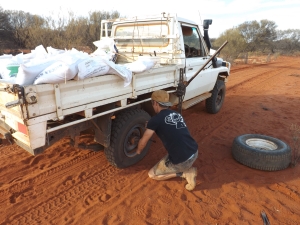
Adam has fulfilled his lifelong ambition of learning to ride a motorbike – as soon as this was mentioned in the job description his eyes lit up and I knew it was a recipe for disaster. They leant him a bike and off he went up and down the runway gaining speed and learning the ropes. It was then time to muster the cows. Mustering is done to move the cows from an area of very little or no water to an area that does have a water supply and they stand a better chance of surviving. Usually the Gyrocopter will fly above and spot the region that the cows are in, then radio down to the guys on the bikes in which direction to move and drive behind to push the cows them forward towards the water. Adam had one fall whereby he stopped moving when he hit a mulga bush which consequently meant he was covered head to toe in thorns. Great for me, very bad for him! I spent hours squeezing, pushing and tweezing the splinters out, and they still aren’t all out.
We are having a great time, and look forward to the other challenges that are brought to face us. Mark, Gill and the boys return back from Port Augusta in a week or so with the new addition of a baby brother or sister. So the house will be full, noisy and back in full working order!
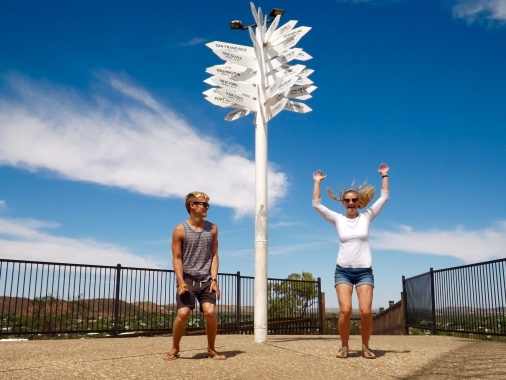

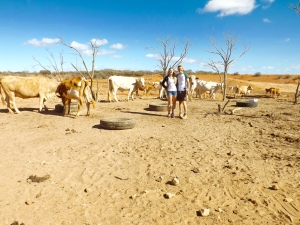
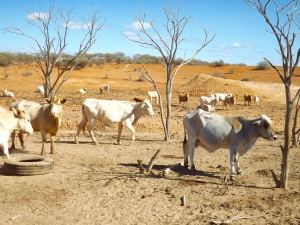
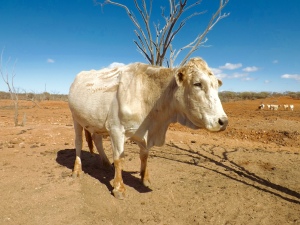
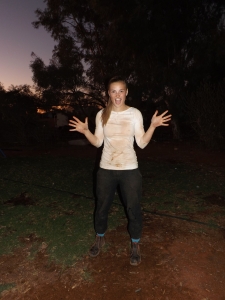
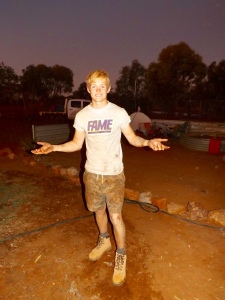
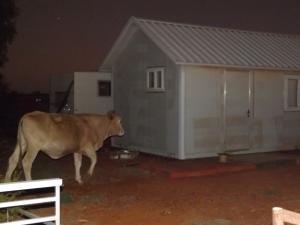
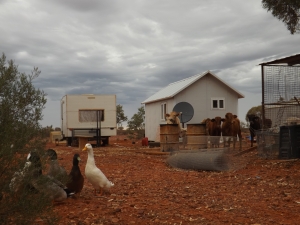
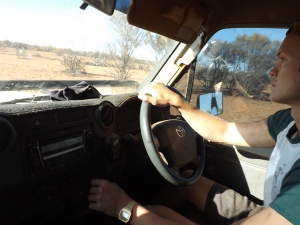
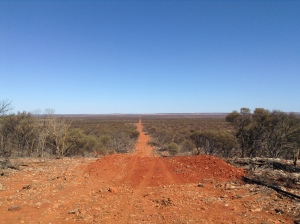
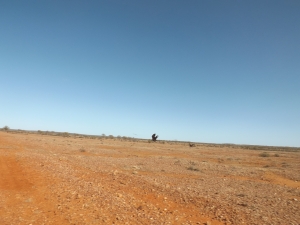
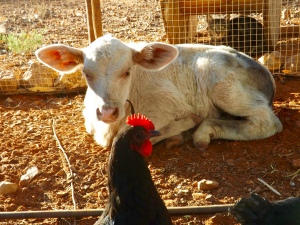
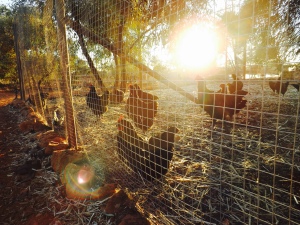
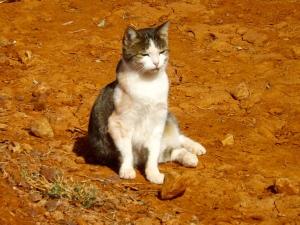
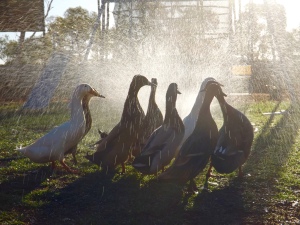
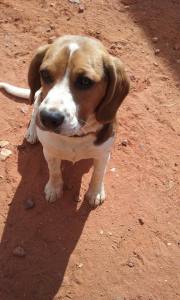
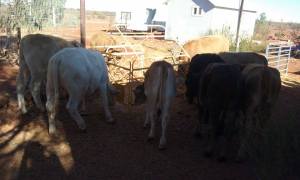
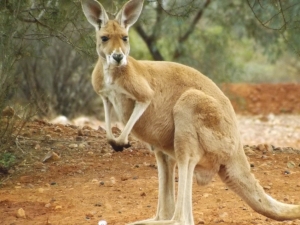
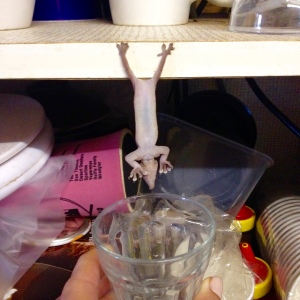
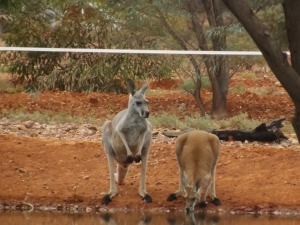
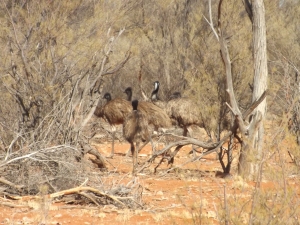
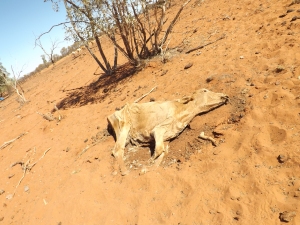
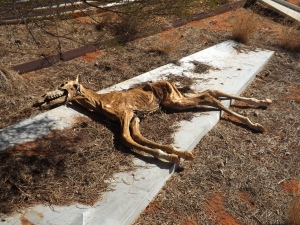
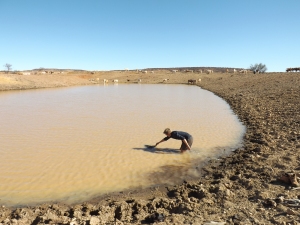
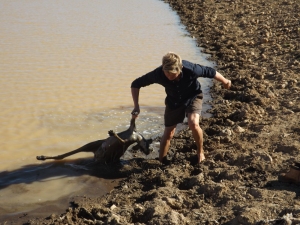
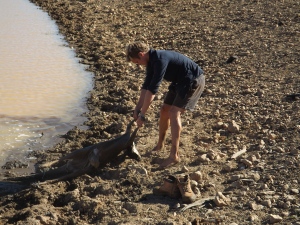
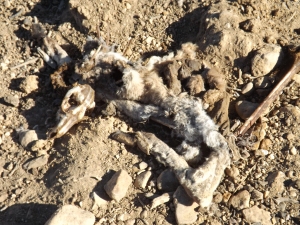
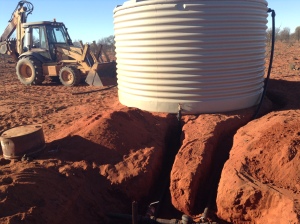
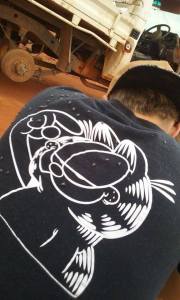

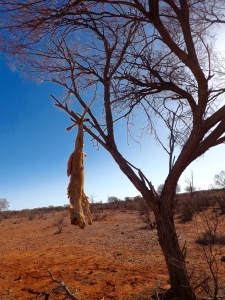
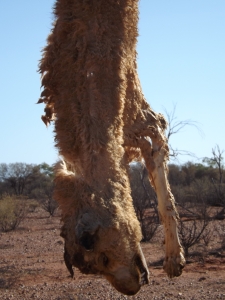
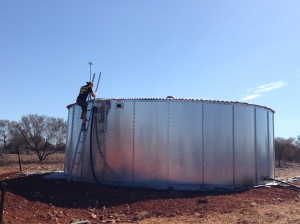
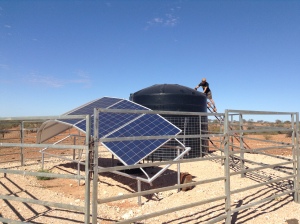
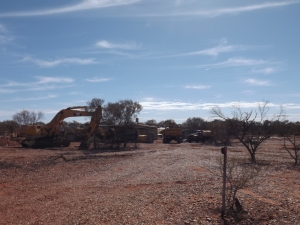
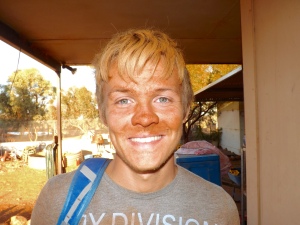
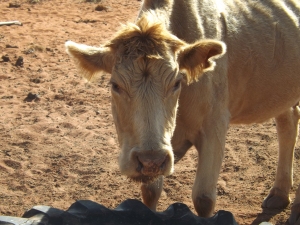
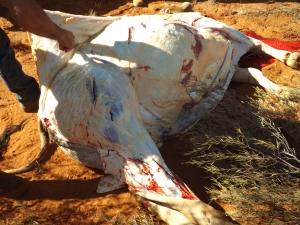
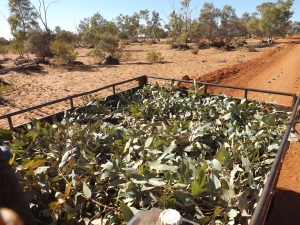
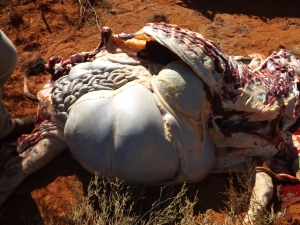
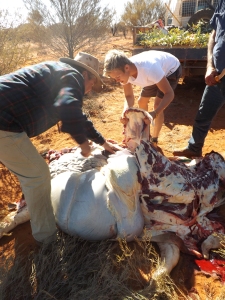
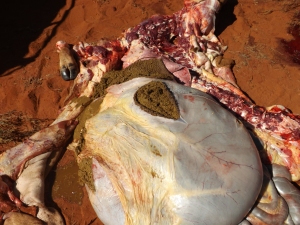
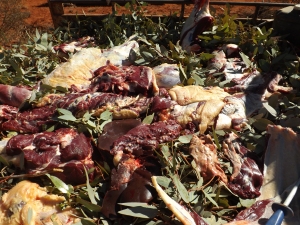
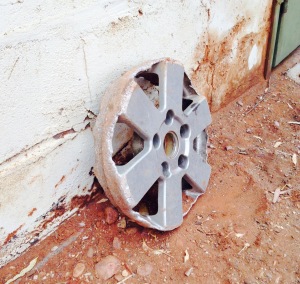
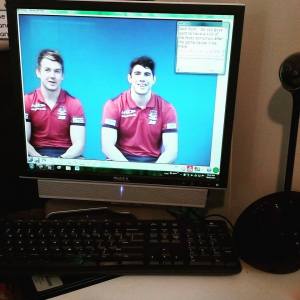
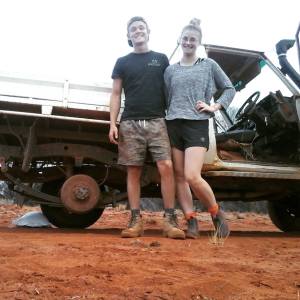
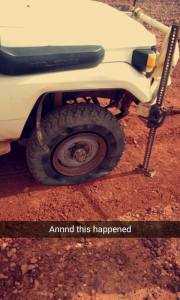
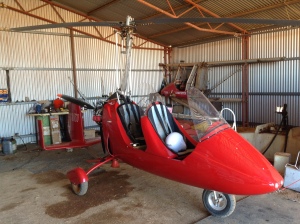
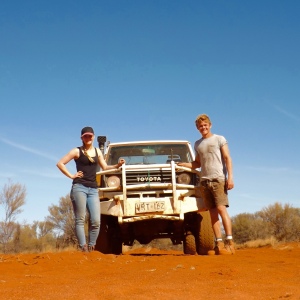
wow that was an awesome read, I’m now exhausted and away for a lie down lol xxx
LikeLike
Had a quick scan over this on my drive to the cities; your lives are incredible! Steph thanks for the beautiful description of skinning the cow…and Adam, Jonny is insanely jealous that you now know how to ride a motorbike (his sons of anarchy obsession is out of hand). You both look amazing despite the red earth and flies and just think of all the things you can now write on your cv; Adams an experienced animal slaughterer and Stephs culinary skills could get her on the British Cook Off! Credit to you both, you amaze me with every post you write. Keep bossin’ it up. Much love xxx
LikeLike
Your employers found a great pair of youngsters for the ranch – looks like you made the more interesting choice too. Thanks for writing!
LikeLike